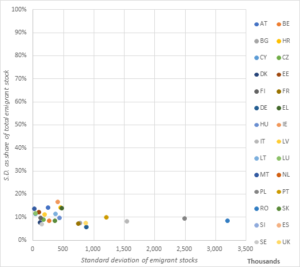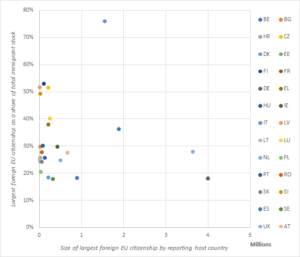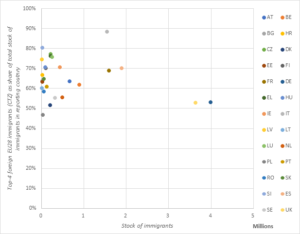Intra-EU migration: Are there higher concentrations of migrants in larger countries?
October 24, 2019
By Zachary Strain and Katrin Marchand
This is the third in a series of blogs exploring major trends in intra-EU migration patterns. Read the previous blogs here and here. More information about the research is available here.
One of the questions that arose during our analysis of the available data on intra-EU migration was, ‘What is the profile of a typical intra-EU migrant?’ There are a number of ways to approach this question, including focusing on:
- country of citizenship/birth,
- country of residence,
- sex, and
- age
For the latter two characteristics, the general pattern is that the countries with the largest absolute immigrant stocks also had the highest stocks of males and females, and of the different age cohorts. Smaller stocks, whether measured as immigrant or emigrant stocks, are more varied when it comes to the balance of sex and age groups. This means that the law of averages applies to both sex and age: as the population increases, the distribution of the characteristics becomes more even.
The situation is a bit more complex when focusing on the first two characteristics. By investigating the data on emigrant stocks, we can shed light on the actual spread of intra-EU migrants among EU Member States.
To begin with, if you were to create a map of Europe where the size of countries was determined by their emigrant stocks (that is, the number of their citizens living elsewhere in the EU), what country would be biggest? As Figure 1 shows, the answer is Romania:

Figure 1: Relative size of Member State emigrant stocks (CTZ) within the EU28, 2017
For 2017, all EU Member States (except Cyprus and Malta) reported their immigrant stocks disaggregated by country of citizenship (Eurostat: migr_pop1ctz). Across these 25 countries, there was an average of 127,632 Romanian citizens in each, and a median of 16,077. Polish citizens came in a close second, with an average of 99,565 emigrants and a median of 14,561 across the 25 reporting countries. The sizeable gap between mean and median values suggests that a sizeable share of the emigrant stocks from these two countries of origin is concentrated in just a few destination countries. This is confirmed when looking at the data, which shows that approximately one third of the 3,190,803 Romanians residing in other EU28 Member States (25 reporting) resided in Italy as of 2017. Similarly, 40% of the Polish citizens residing outside of Poland (but within the EU28) were in the United Kingdom. Both of these migration corridors, along with two others, were discussed in a previous blog on the largest bilateral stock corridors in the EU28. The standard deviation of emigrant stocks by citizenship are the highest for Romania and Poland as well. However, does this mean that large emigrant stocks tend to be heavily concentrated in a single country?
We expect that larger emigrant stocks will have a higher standard deviation than smaller ones. Now, consider Figure 2 below. Even though standard deviations get bigger as emigrant stocks get bigger, there is a fairly consistent ratio between the two: an average of 1 to 10 (standard deviation to emigrant stock). So, even while the emigrant stocks of Polish and Romanian citizens are the highest among reporting Member States, it seems that they are, in relative terms, not spread any differently than the stocks of countries with smaller numbers of emigrants.

Figure 2: Standard deviation as a share of total emigrant stocks (CTZ), 2017
Shifting to the host country perspective, citizens of Romania and Poland account for 76% and 28% of the foreign citizens in Italy and the UK respectively. Italy and the UK are each top host countries of intra-EU migrants among Member States, but do larger emigrant stocks of a specific citizenship make up a majority of the immigrant stock in a given country?
Firstly, we do not see a correlation between the size of a host country’s immigrant stock and the share of the top foreign citizenship group within it; larger immigrant stocks do not equate to higher shares of a single foreign citizenship (see Figure 3). However, only looking at the share of the top citizenship of origin paints a limited picture. Perhaps it could be the case that, the larger the immigrant stock of a country, the higher the likelihood that immigrants will have only a few countries of citizenship?

Figure 3: Top foreign member state citizenship shares of aggregate immigrant stocks by reporting country, 2017
Digging deeper, as done in Figure 4, we see that, in every reporting Member State except Poland, at least 50% of the immigrant stock is comprised of no more than four foreign citizenships. Another pattern we see is that five countries of citizenship (Germany, Italy, Poland, Romania, and United Kingdom) most often occupy a position in the top four spots in a majority of Member States. On the other hand, there are four countries of citizenship (Cyprus, Estonia, Luxembourg, and Malta) that most often occupy the bottom four. This is somewhat to be expected, since the first five countries of citizenship are also among the largest sending countries in the first place. The same goes for the bottom four countries of citizenship, which are among the smallest sending countries.

Figure 4: Top-4 member state citizenships as shares of aggregate immigrant stocks by reporting country, 2017
What about the immigrant stock with a specific citizenship as compared to the population of the host country? As discussed in our working paper, the relative share of the immigrant stock to a country’s population varies. There is virtually no correlation between the size of the population of a country and the relative size of its immigrant stock.
Overall, analyzing the spread of intra-EU migrants across Member States based on the data provided by Eurostat leads to three main conclusions:
Firstly, emigrants of a single citizenship tend to be evenly distributed across Member States relative to the population of the host country. That is, the UK and Italy may host a higher number of Polish and Romanian citizens respectively than do other countries, but they also have higher overall populations.
Secondly, there is virtually no correlation between the population size of a Member State and the relative size of its intra-EU immigrant stock. There is even less correlation for third-country nationals.
Thirdly, Member States with larger populations are no more likely to have higher shares of specific citizenships in their immigrant stocks than smaller Member States. In fact, in all EU Member States except Poland, more than 50% of the respective intra-EU immigrant stocks are comprised of no more than four foreign citizenships, which are often from countries with the highest stocks of emigrants, namely: Germany, Italy, Poland, Romania, and United Kingdom. As such, the total resident population of a Member State alone is not a reliable indicator for the relative share of foreign EU nationals. In other words, bigger countries do not have bigger immigrant stocks, relatively speaking.
Katrin Marchand is a postdoctoral researcher at UNU Merit, based at the Maastricht Graduate School of Governance.
Zachary Strain is a research consultant at the Maastricht School of Governance.
